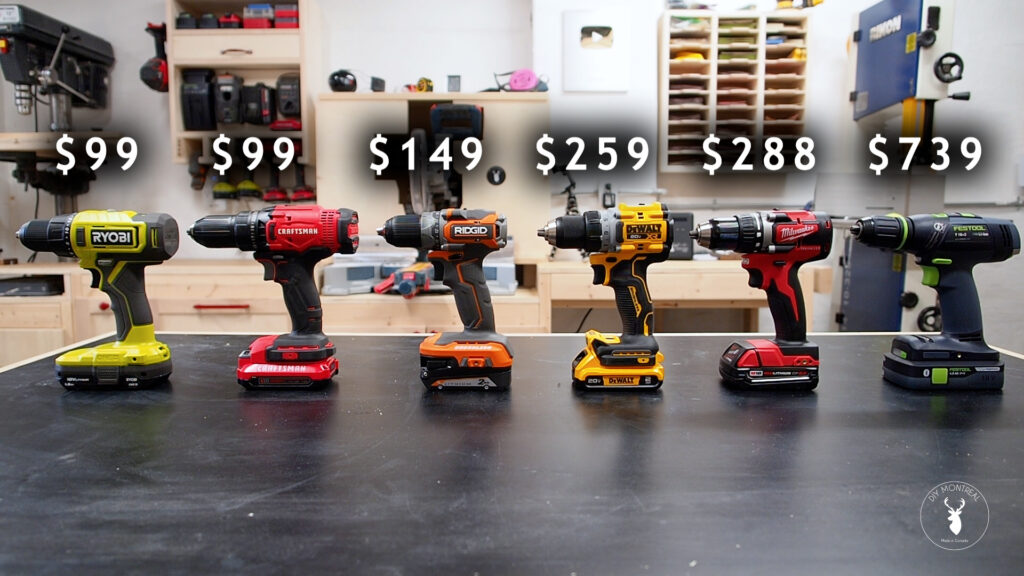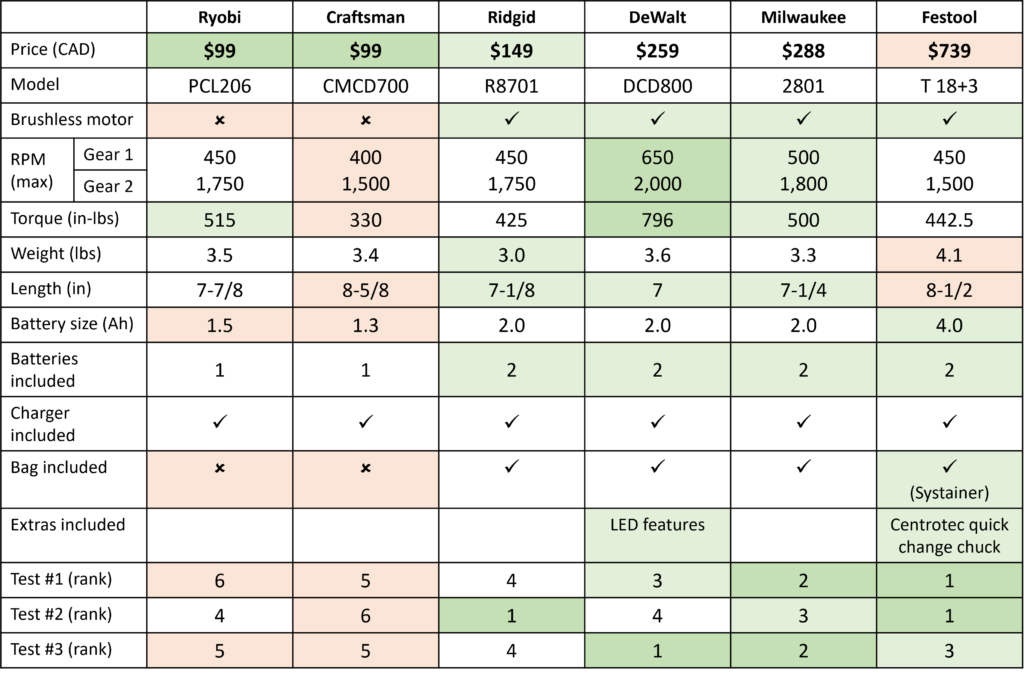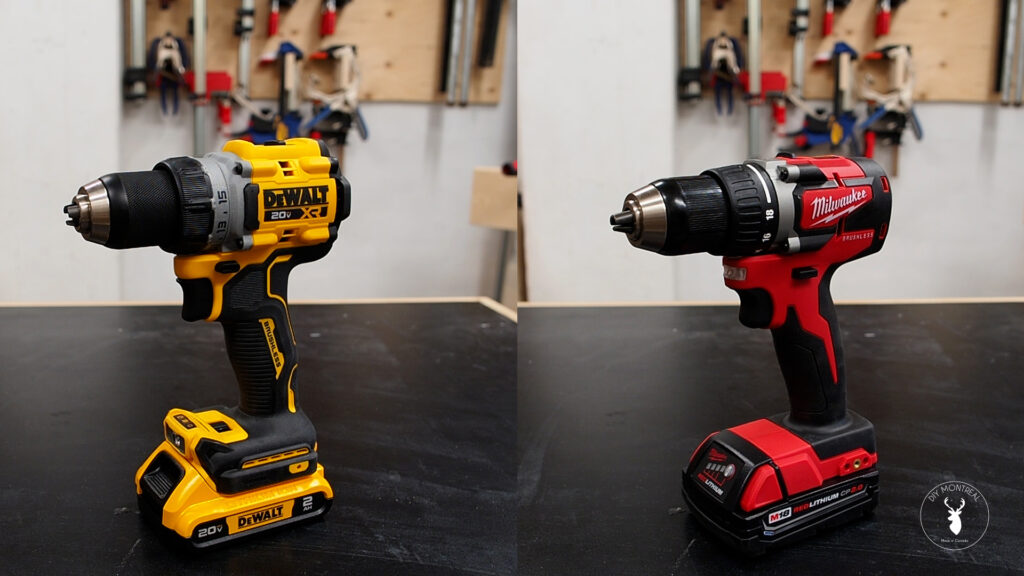I get a lot of pushback because of the fact that I use entry-level drills. You’ll either see me using a Ryobi drill or a Craftsman drill, and frankly I’m happy with them. They do the job I need them to do, and they didn’t break the bank.
I didn’t choose these drills because I’m cheap. I invest in plenty of tools when I think the added features are worth the cost. But when it comes to drills, I just don’t believe that more expensive is better.
Am I wrong? Well, today I’m putting some of the most popular brands to the test to find out. And I can tell you now, you’ll be surprised by the results!
Are more expensive drills really worth it?
Going into this test, I honestly believed that there would be little difference between the performance of the more expensive drills and the less expensive drills. Well, I was wrong. That said, the most expensive drills didn’t necessarily do the best, and there were some surprises for one of the underdogs too!
Choosing Which Drills to Test
To pick out which drills to include in this test, I first did some online research. I came across articles like CNET’s Best Cordless Drill of 2023 and The Spruce’s 12 Best Cordless Drills of 2023. I wasn’t surprised see DeWalt and Milwaukee drills at the top of these lists.
The more I read these “top drills of 2023” articles, the more confused I got. The specs on the drills being tested were all over the place. Comparing 12v to 18v drills, brushed and brushless motors, and some with hammer drill settings. It just didn’t seem like they were comparing apples to apples.
With that in mind, I set the drill inclusion criteria as follows:
- 18v or 20v (no 12v)
- 1/2-inch chuck (vs. 3/8 chuck on less powerful drills)
- Brushed motor (for the cheaper drills) OR brushless motor (for mid-to-high-end drills)
- NO hammer mode setting
- Entry level battery (1.3-2.0 Ah) *Except Festool (4.0Ah)
Drill Models Tested
As I mentioned before, the goal here isn’t to find the best drill of 2023. The question here is Are more expensive drills really better? With that in mind, here is the drill lineup I chose to include in the testing.

On the low end of the scale both coming in at $99 (BTW these prices are in Canadian dollars), we have the Ryobi 18v and the Craftsman v20. These are actually the same drills I happen to use in my shop on a regular basis (but these ones are brand new). These both have brushed motors.
In the low-to-mid-range at $149 we have a Ridgid 18v drill with added value supposedly being its brushless motor and sub-compact design. It also comes with two (2) 2.0 Ah batteries which is a step up from the 1.3 and 1.5 Ah batteries that come with the Craftsman and Ryobi drills.
In the mid-to-high-range we have the extremely popular DeWalt drill. This one is the DeWalt 20v MAX XR. It has a brushless motor, comes with two (2) 2.0 Ah batteries and sells for $259. The specs (torque & RPM) on this DeWalt drill are neck above the others, as you can see in the table further down.
The Milwaukee M18 is very comparable to the DeWalt with a slightly higher price point at $288. It’s a compact brushless 18v drill that features the same brushless motor and comes with two (2) 2.0 Ah batteries.
And last but not least, on the high end of the spectrum (some would even say premium) I decided to include the Festool T18+3 which seems to be popular among woodworkers and carpenters. The tool alone is $425 or a whopping $739 for the kit with (2) 4.0 Ah batteries and a charger. It’s of course got a brushless motor and is the only one to come with 2 different chucks. A standard one for drilling and a quick change Centrotec chuck for driving screws.
So here’s a summary of our drill lineup:

How I’ll Test the Drills
Let me first get this out of the way. Every tool I’m testing is brand new with brand new batteries (all paid with my own money – this post is not sponsored in any way). I started with a full charge for every test I ran, and also used a new drill/driver bit for each tool tested.
So will I test these drills?
First I’ll evaluate the obvious physical features of each: weight, overall size and clearance required, grip/comfort, ease of use, LED light, as well as the official specs listed on the package (speed & torque).
Next I’ll subject each of these to various stress-tests to evaluate the speed, torque, power and longevity of each drill. I’ll drill a bunch of holes and drive a bunch of screws, and tally up all the results.
- Test #1 – Speed Drilling – How long will it take to drill 10 holes using a 1″ paddle bit?
- Test #2 – Driving screws until the battery runs out – How long does the battery last on a single change?
- Test #3 – Timed Lag Screw Test – How many leg screws can be driven in 30 seconds?
If you want to see how each drill performed (spoiler alert: one of them started smoking!) be sure to watch the YouTube video.
Best Drill of 2023

Okay, so I finally get it. I’ve been living in the dark ages this whole time with my Ryobi and Craftsman drills. As you can see by the specs and performance of each drill in the table above, the difference between these drills and the more expensive ones is clear. I mean, there’s no way you could work in the trades using an entry-level drill. They’re just not powerful enough.
That being said, I don’t have the same needs as an electrician or plumber or deck builder. I only use drills on occasion to drill pilot holes and drive a few screws. Do I like the high-end drills better than the ones I have? Yeah, for sure! But do I need them? Not necessarily…
Don’t worry, I’m not going to be one of those people who does a review and then doesn’t name a clear winner. I will say it depends on your needs but if I were to pick one of these drills to use in my shop from here on out, it would have to be either Milwaukee or Dewalt. I think both are strong contenders and have their minor advantages and drawbacks at similar price points.

The specs on DeWalt take the cake, but they’re almost overkill, causing potential wrist injuries. I do however like the oversized LED, with a switch to control it. It is a tad heavier than Milwaukee though, so again, minor trade offs. I think ultimately I’d have to look at the entire tool line-up for both brands and decide which tool line I’d rather buy into for the long run.
As far as the other drills go…
Festool is indeed in a league of its own. So powerful and smooth. But it didn’t always perform the best overall. Its torque is actually slightly underwhelming. It’s also the heaviest and one of the biggest drills I tested, which is a big turnoff for me. And the price tag is way too high. So Festool is a pass for me.
Ridgid was a pleasant surprise though. It performed fairly well overall given its price point and probably the best value for money in my book.
Craftsman performed the worst overall and Ryobi didn’t do much better, as I’m sure most people won’t be surprised to hear. They lacked speed and power in most tests, and they’re bigger and clunkier than most competitors.
That said, a drill is usually just the gateway to the entire line of tools. I’ve always liked that Ryobi and Craftsman have a whole line of entry level tools that run on the same batteries, and I already own many of these tools. So is the added value of the DeWalt or Milwaukee drill enough to make me want to switch everything over? I’m not so sure.
But to answer the question: are more expensive drills really worth it? Absolutely. The high end drills definitely pack more power than the entry-level drills. As they say, you get what you pay for.

1 comments on “Are more expensive drills really better?”